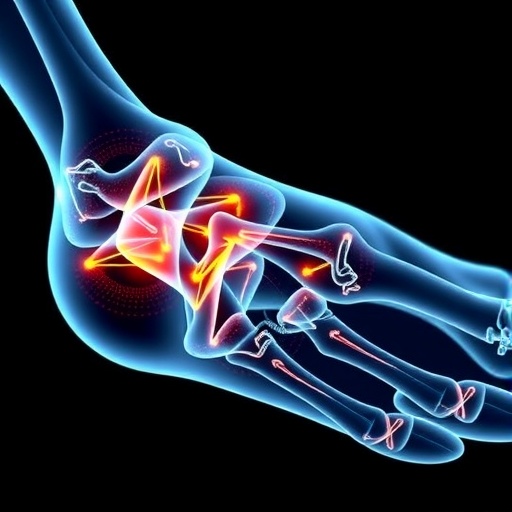In a groundbreaking advancement within the field of regenerative medicine, a recent study reveals a novel engineered biphasic scaffold designed for enhanced bone regeneration, devoid of growth factors. The research, led by a team of innovators—including Wijekoon, Wang, and Abdulmalik—marks a significant shift in how we approach bone healing, paving the way for effective solutions to address fractures, non-union injuries, and other bone-related ailments. The implications of this development could resonate profoundly in clinical applications, offering hope to millions around the globe who suffer from bone degeneration or injury.
Traditional approaches to bone regeneration have typically relied on the administration of growth factors to stimulate tissue healing. However, the need for these biologically active proteins often presents logistical challenges, including sourcing, stability, and potential immunogenicity. The research team took a decisive step by eliminating the reliance on these factors, thereby creating a more streamlined and potentially more reliable solution. The engineered biphasic scaffold focuses on mimicking the natural bone environment, which is pivotal for successful tissue regeneration.
The scaffold is meticulously designed, incorporating two distinct phases that play crucial roles in the healing process. The first, an osteoconductive phase, serves as a foundation that promotes the growth of bone cells, while the second, an osteoinductive phase, encourages the transformation of progenitor cells into bone-forming cells. This dual-phase approach not only accelerates the healing process but also ensures that bone regeneration is both effective and durable.
Research conducted in vitro demonstrates that the biphasic scaffold supports significant osteogenic activity, promoting bone cell proliferation and differentiation. Experimental results indicate a marked increase in mineralization compared to control groups, suggesting that the scaffold not only supports but enhances bone formation. Such compelling evidence highlights the scaffold’s capacity as a revolutionary tool in bone regenerative therapies.
Moreover, the safety profile of this engineered scaffold has been rigorously evaluated, with preliminary studies indicating biocompatibility and minimal inflammation upon implantation. These findings are critical, as they assure clinicians and patients alike that this innovative technology can be safely employed in clinical settings. As the research team continues to refine and optimize the scaffold, upcoming studies will likely expand on these initial promising results.
One of the pivotal inquiries regarding the scaffold pertains to its mechanical properties. Bone healing is not only a biological process but also a biomechanical one. The scaffolds have been engineered to possess mechanical strength that mirrors that of natural bone, providing the necessary structural support during the healing phase. This is particularly important in load-bearing applications, where the scaffold must endure physical forces without compromising the healing process.
The researchers are also investigating the long-term outcomes associated with the biphasic scaffold, particularly its integration with host bone. Successful integration is essential for sustained healing and functionality, preventing complications such as graft rejection or non-union. Preliminary findings suggest that the engineered scaffolds exhibit robust bonding with surrounding bone tissue, facilitating a harmonious reconstruction.
The implications of this research are far-reaching. For patients, this technology could mean a reduced need for surgical interventions, lower costs associated with biologic treatments, and shorter recovery times. Healthcare systems stand to benefit significantly as well, with the potential for improved patient outcomes translating into cost savings and enhanced resource allocation.
Collaboration will play a crucial role in advancing this innovative research. The scientists involved call upon orthopedic specialists, biomaterials experts, and regulatory bodies to partner in navigating the pathway from bench to bedside. A collective effort is necessary to fully understand the scaffold’s capabilities and limitations while ensuring adherence to safety and efficacy standards.
As we look to the future, the potential applications of growth factor-free engineered scaffolds in areas beyond bone regeneration are beguiling. From cartilage repair to tissue engineering, the principles embedded in this research could initiate a ripple effect, inspiring new methodologies across various domains of regenerative medicine. Transformative breakthroughs often stem from the challenging of existing paradigms, and this study could exemplify that journey.
Public interest in biotechnological advances, especially those promising real change in healthcare, has been notable. This study could attract attention not only from medical professionals but also from the general public empowered by advancements that improve quality of life. Greater awareness will undoubtedly be instrumental in accelerating the adoption and implementation of such innovative therapies in clinical practices worldwide.
In conclusion, the advancement of growth factor-free engineered biphasic scaffolds for enhanced bone regeneration marks a pivotal moment in science and medicine. With promising preclinical results and a focus on improving the lives of individuals with bone injuries, the future of regenerative therapies looks brighter than ever. Continued research, collaboration, and innovation will be vital to harness the full potential of these technological marvels, opening doors to new therapeutic avenues that resonate well beyond the realms of bone healing.
Subject of Research: Engineered biphasic scaffold for bone regeneration
Article Title: Growth Factor-Free Engineered Biphasic Scaffold for Enhanced Bone Regeneration
Article References:
Wijekoon, S., Wang, W., Abdulmalik, S. et al. Growth Factor-Free Engineered Biphasic Scaffold for Enhanced Bone Regeneration.
Ann Biomed Eng (2025). https://doi.org/10.1007/s10439-025-03857-1
Image Credits: AI Generated
DOI: 10.1007/s10439-025-03857-1
Keywords: Bone regeneration, biphasic scaffold, engineered materials, regenerative medicine, osteogenesis, biomaterials, tissue engineering.




